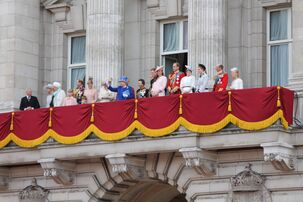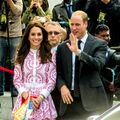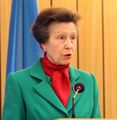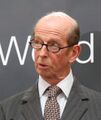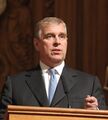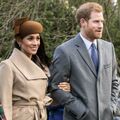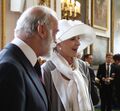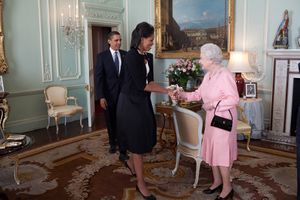العائلة المالكة البريطانية
The British royal family comprises King Charles III and his close relations. There is no strict legal or formal definition of who is or is not a member, although the Royal Household has issued different lists outlining who is a part of the royal family.[1][2] They support the monarch in undertaking public engagements and often pursue charitable work and interests. The royal family are regarded as British cultural icons.
Members
The head of state of the United Kingdom and 14 other Commonwealth realms is King Charles III. He is the head of the royal family. He has two children and five grandchildren. The Lord Chamberlain's "List of the Royal Family" mentions all of Elizabeth II's descendants and their spouses (including Sarah, Duchess of York, who is divorced), along with the King's cousins with royal rank and their spouses.[2] The Lord Chamberlain's list applies for the purposes of regulating the use of royal symbols and images of the family.[3] Meanwhile, the website of the royal family provides a list of "Members of the Royal Family"; those listed correspond to the royal family members mentioned and pictured below, with the exception of Princess Beatrice, Princess Eugenie, and the Duchess of Kent.[4] The royal family's guidelines on greeting a member of the royal family say they should first be greeted with "Your Royal Highness".[5] The status of Royal Highness is restricted to children of a monarch, male-line grandchildren of a monarch, the children of the eldest child of the Prince of Wales, and their wives.
- The core of the royal family is made up of King Charles III; Camilla, Queen consort; William, Prince of Wales; Catherine, Princess of Wales; Anne, Princess Royal; Prince Edward, Earl of Wessex; and Sophie, Countess of Wessex. They carry out royal duties full-time.[6]
- Lower profile relatives who perform some duties are Prince Edward, Duke of Kent; Princess Alexandra; Prince Richard, Duke of Gloucester; and Birgitte, Duchess of Gloucester.[6]
- Other members of the royal family with royal rank who do not carry out official duties are Prince Andrew, Duke of York; Prince Harry, Duke of Sussex; Meghan, Duchess of Sussex; Princess Beatrice; Princess Eugenie; Katharine, Duchess of Kent; and Prince and Princess Michael of Kent.[6]
The King and Queen Consort
The Prince and Princess of Wales
The Princess Royal
The Earl and Countess of Wessex
The Duke of Kent
The Duke and Duchess of Gloucester
The Duke of York
The Duke and Duchess of Sussex
The Duchess of Kent
قالب:Current British royal family tree
Titles and surnames
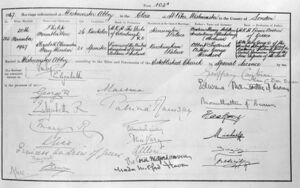
The monarch's children and patrilineal grandchildren, and the children of the eldest son of the Prince of Wales, are automatically entitled to be known as prince or princess with the style His or Her Royal Highness (HRH).[7] Peerages, often dukedoms, are bestowed upon most princes prior to marriage.[8][9] Peter Phillips and Zara Tindall, children of the King's sister, Princess Anne, are therefore not prince and princess. Lady Louise Mountbatten-Windsor and James Mountbatten-Windsor, Viscount Severn, though entitled to the dignity, are not called prince and princess because their parents, the Earl and Countess of Wessex, wanted them to have more modest titles.[7] The King reportedly wants to reduce the number of titled members of the royal family.[10]
Per tradition, wives of male members of the royal family share their husbands' title and style.[11] Princesses by marriage do not have the title prefixed to their own name[7] but to their husband's; for example, the wife of Prince Michael of Kent is Princess Michael of Kent.[11] Sons of monarchs are customarily given dukedoms upon marriage, and these peerage titles pass to their eldest sons.[11]
Male-line descendants of King George V, including women until they marry, bear the surname Windsor. The surname of the male-line descendants of Queen Elizabeth II, except for women who marry, is Mountbatten-Windsor, reflecting the name taken by her Greek-born husband, Prince Philip, Duke of Edinburgh, upon his naturalisation. A surname is generally not needed by members of the royal family who are entitled to the titles of prince or princess and the style His or Her Royal Highness. Such individuals use surnames on official documents such as marriage registers.[12]
Public role

During the reign of Queen Elizabeth II, official duties were undertaken on her behalf by her children and their spouses, grandchildren and their spouses, and cousins and their spouses. Among her cousins, only the children of King George V's sons carry out royal engagements. The family supported the Queen in her state and national duties, with the exception of constitutional functions.[13][14]
If the sovereign is indisposed, two Counsellors of State are required to fulfil his role, with those notionally eligible being restricted to the Prince of Wales, the Duke of Sussex, the Duke of York and Princess Beatrice.[14]
Each year the family "carries out over 2,000 official engagements throughout the UK and worldwide", entertaining 70,000 guests and answering 100,000 letters.[13][15] Engagements include state funerals, national festivities, garden parties, receptions, and visits to the Armed Forces.[13] Many members have served in the Armed Forces themselves, including the King's brothers and sons.[16][15] Engagements are recorded in the Court Circular, a list of daily appointments and events attended by the royal family.[17] Public appearances are often accompanied by walkabouts, where royals greet and converse with members of the public outside events.[18]
Annual events attended by the royal family include the State Opening of Parliament, Trooping the Colour, and the National Service of Remembrance.[14] According to historian Robert Lacey, Elizabeth II once said that investitures of the honours recipients are the most important thing she does.[19] Prince William and Princess Anne also perform investitures.[20][14] Family members represent the King on official visits and tours to other countries as ambassadors to foster diplomatic relations.[16][15][21] They have also attended Commonwealth meetings on the monarch's behalf.[14] The royal family also participates in state visits on the advice of the Foreign and Commonwealth Office, which includes the welcoming of dignitaries and a formal banquet.[22] Journalist James Forsyth has referred to the family as "soft power assets".[23]
Given the royal family's public role and activities, it is sometimes referred to by courtiers as "The Firm", a term that originated with George VI.[24][25] Members of the royal family are politically and commercially independent, avoiding conflict of interest with their public roles.[26] The royal family are considered British cultural icons, with young adults from abroad naming the family among a group of people who they most associated with British culture.[27] Members are expected to promote British industry.[28] Royals are typically members of the Church of England, headed by the monarch, and have previously served as Lord High Commissioner to the Church of Scotland.[29][30]
Members of the royal family are patrons for approximately 3,000 charities,[15] and have also started their own nonprofit organisations.[16] The King started The Prince's Trust, which helps young people in the UK that are disadvantaged.[31] Princess Anne started The Princess Royal Trust for Carers, which helps unpaid carers, giving them emotional support and information about benefit claims and disability aids.[32] The Earl and Countess of Wessex founded the Wessex Youth Trust, since renamed The Earl and Countess of Wessex Charitable Trust, in 1999.[33] The Prince and Princess of Wales are founding patrons of The Royal Foundation, whose projects revolve around mental health, conservation, the early years, and emergency responders.[34]
In 2019, following the negative reactions to the "Prince Andrew & the Epstein Scandal" interview, the Duke of York was forced to resign from public roles; the retirement became permanent in 2020.[35] The Duke and Duchess of Sussex permanently withdrew from royal duties in early 2020.[36] Following these departures, there is a shortage of royal family members to cover the increasing number of patronages and engagements.[6]
Media and criticism
Royal biographer Penny Junor says that the royal family has presented itself "as the model family" since the 1930s.[6] Author Edward Owen wrote that during the Second World War, the monarchy sought an image of a "more informal and vulnerable family" that had a unifying effect on the nation during instability.[37] In 1992, the Princess Royal and her husband Mark Phillips divorced; the Prince and Princess of Wales separated; a biography detailing the Princess's bulimia and self-harming was published; her private telephone conversations surfaced, as did the Prince's intimate telephone conversations with his lover, Camilla Parker Bowles; the Duke and Duchess of York separated; and photographs of the topless Duchess having her toes sucked by another man appeared in tabloids. Historian Robert Lacey said that this "put paid to any claim to being a model of family life". The scandals contributed to the public's unwillingness to pay for the repairs of the Windsor Castle after the 1992 fire. A further "PR disaster" was the royal family's initial response to the death of Diana, Princess of Wales, in 1997.[19]
In the 1990s, the royal family formed the Way Ahead Group, made up of senior family members and advisers and headed by Elizabeth II, in a quest to change in accordance with public opinion.[19][38] The 2011 wedding of Prince William and Catherine Middleton led to a "tide of goodwill", and by Elizabeth II's Diamond Jubilee in 2012 the royal family's image had recovered.[19] A 2019 YouGov poll showed that two-thirds of British people were in favour of maintaining the royal family.[39] The role and public relations of the extended royal family again came under increased scrutiny due to the Duke of York's friendship with convicted sex offender Jeffrey Epstein and allegations of sexual abuse, along with his unapologetic conduct in the 2019 interview about these subjects and subsequent 2021 lawsuit.[40][41][42]
In a 2021 interview, the Duchess of Sussex, who is of biracial heritage, relayed second-hand that there had been "concerns and conversations" within the royal family about the skin colour of their son, Archie Mountbatten-Windsor, while the Duke of Sussex stated it was a single instance.[43] The interview received a mixed reaction from the British public and media, and several of their claims were called into question.[44][45] The Duke of Cambridge said the royal family were "very much not a racist family". In June 2021, documents revealed that "coloured immigrants or foreigners" were banned by Elizabeth II's chief financial manager at the time from working for the family as clerks in the 1960s, prompting black studies professor Kehinde Andrews to state that "the royal family has a terrible record on race".[43] In response, the palace stated that it complied "in principle and in practice" with anti-discrimination legislation, and that second-hand claims of "conversations from over 50 years ago should not be used to draw or infer conclusions about modern-day events or operations."[46] In March 2022 and during the Caribbean tour of the Duke and Duchess of Cambridge as part of the Queen's Platinum Jubilee celebrations, the family encountered criticism from a number of political figures and the press, given their past connections to colonialism and the Atlantic slave trade via the Royal African Company.[47][48] Reparations for slavery emerged as a major demand of protesters during the couple's visit.[49] Both the Prince of Wales and the Duke of Cambridge have condemned slavery in their speeches,[50][51] and the Prince has described acknowledging the wrongs of the past as a necessity for the Commonwealth countries to realise their potential.[52]
Historically, the royal family and the media have benefited from each other; the family used the press to communicate with the public, while the media used the family to attract readers and viewers.[53] With the advent of television, however, the media started paying less respect to the royal family's privacy.[19] Princes William and Harry have had informal arrangements with the press whereby they would be left alone by the paparazzi during their education in return for invitations to staged photograph opportunities. William has continued the practice with his family posts on Instagram. Relations between the media and British royals have been destabilized by the rise of the digital media, with the quantity of articles becoming paramount toward gaining advertising revenue, with neither side able to exercise control.[53] In the 2000s, the phones of Prince William and Catherine Middleton, and Prince Harry and his then-girlfriend Chelsy Davy, were hacked multiple times by media outlets, most notably by a private investigator working for a News of the World journalist.[54][55] A 2021 BBC documentary suggested that briefings and counter-briefings from different royal households was the reason behind the negative coverage about members of the royal family. Buckingham Palace, Clarence House and Kensington Palace, which represent the Queen, the Prince of Wales and the Duke of Cambridge respectively, described these suggestions as "overblown and unfounded claims".[56]
Funding
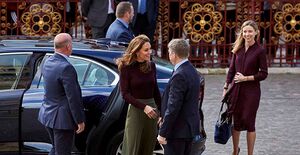
Senior members of the royal family, who represent the monarch, draw their income from public funds known as the sovereign grant.[57] The sovereign grant is an annual payment of the British government to the monarch. It comes from the revenues of the Crown Estate, which are commercial properties owned by the Crown.[58] Members of the royal family who receive money from the sovereign grant must be accountable to the public for it and are not allowed to make money from their name.[57]
The security of the royal family is not paid from the sovereign grant but is usually met instead by the Metropolitan Police.[59] The royal family, the Home Office, and the Metropolitan Police decide which members have a right to taxpayer-funded police security. Extended members do not retain automatic right to protection; in 2011, Princesses Beatrice and Eugenie ceased receiving police security.[10][60]
Residences
The monarch's official residence in London is Buckingham Palace.[58] Announcements of the births and deaths of members of the royal family are traditionally attached to its front railings.[61] Queen Elizabeth II's Scottish residence was the Palace of Holyroodhouse, where she resided at the beginning of each summer.[62] While in Northern Ireland, Hillsborough Castle serves as a residence for members of the royal family.[62]
Clarence House served as the official residence of Charles III when he was Prince of Wales from 2003 until he inherited the throne on 8 September 2022.[58] Another London residence of the Prince of Wales is St James's Palace, which he shares with the Princess Royal and Princess Alexandra.[63] Princess Alexandra also resides at Thatched House Lodge in Richmond.[64] The Prince and Princess of Wales and the Duke and Duchess of Gloucester have their residences and offices at apartments in Kensington Palace, London.[65][66] The Duke and Duchess of Kent reside in Wren House on the palace grounds.[67] The Duke and Duchess of Sussex's official residence in the United Kingdom is Frogmore Cottage.[68][69] The Duke of York lives at the Royal Lodge in Windsor Great Park, while the Earl and Countess of Wessex reside at Bagshot Park in Surrey.[70][71]
See also
- Education of the British royal family
- List of honours of the British royal family by country
- List of longest-living members of the British royal family
- Military service by British royalty
- Republicanism in the United Kingdom
- Royal descent
References
- ^ "Royal Family". royal.gov.uk. Archived from the original on 11 December 2021. Retrieved 11 December 2021.
- ^ أ ب "List of the Royal Family" (PDF). royal.gov.uk. Archived (PDF) from the original on 15 August 2020. Retrieved 11 December 2021.
- ^ "Use of Royal Arms, Names and Images". royal.gov.uk. Archived from the original on 29 October 2019. Retrieved 11 December 2021.
{{cite web}}:|archive-date=/|archive-url=timestamp mismatch; 29 أكتوبر 2021 suggested (help) - ^ "Royal Family". royal.gov.uk. Archived from the original on 11 December 2021. Retrieved 11 December 2021.
- ^ "Greeting a Member of the Royal Family". royal.gov.uk. Archived from the original on 13 December 2021. Retrieved 13 December 2021.
- ^ أ ب ت ث ج Davies, Caroline (21 April 2021). "Sophie and Edward: what key role after death of Prince Philip could mean". The Guardian. Retrieved 4 August 2020.
- ^ أ ب ت Boyle, Christina (10 May 2019). "Archie, the newest British royal family member, has no title. Here's why (we think)". Los Angeles Times. Retrieved 4 August 2020.
- ^ Abraham, Ellie. "How Do British Royals Get Their Titles?". The Independent. Retrieved 15 November 2021.
- ^ Abrams, Maragret. "What is a duke? And how is the title different from a prince?". Evening Standard. Retrieved 15 November 2021.
- ^ أ ب Davies, Caroline (8 March 2021). "Was Meghan's son Archie denied the title 'prince' because he's mixed race?". The Guardian. Retrieved 4 August 2020.
- ^ أ ب ت "FAQs - Prince Michael of Kent". www.princemichael.org.uk. Retrieved 4 August 2021.
- ^ "The Royal Family name". The Royal Family. Retrieved 30 June 2019.
- ^ أ ب ت "The role of the Royal Family". The Royal Family. 23 March 2016. Retrieved 30 June 2019.
- ^ أ ب ت ث ج Davies, Caroline (29 October 2021). "The royal we: subtle transition as ageing Queen devolves more duties". The Guardian. Retrieved 15 November 2021.
- ^ أ ب ت ث Praderio, Caroline. "Here's What The Royal Family Actually Does Every Day". The Independent. Retrieved 15 November 2021.
- ^ أ ب ت "UK Royal Family: Who is in it and how does it work?". BBC. 9 April 2021. Retrieved 15 November 2021.
- ^ Said-Moorhouse, Laure. "The Queen returns to royal duties following Prince Philip's death". CNN. Retrieved 15 November 2021.
- ^ Lam, Katherine. "Queen Elizabeth's daughter Princess Anne explains why she doesn't shake fans' hands". Fox News. Retrieved 15 November 2021.
- ^ أ ب ت ث ج Davies, Caroline (24 May 2012). "How the royal family bounced back from its 'annus horribilis'". The Guardian. Retrieved 4 August 2021.
- ^ "Investitures". The Royal Family. Retrieved 3 August 2020.
- ^ "Royal diplomacy to play key role in life after Brexit". ITV News. Retrieved 15 November 2021.
- ^ "State Visits". The Royal Family. Retrieved 15 November 2021.
- ^ Forsyth, James (13 August 2021). "Britain needs the royal family more than ever". The Times. Retrieved 15 November 2021.
- ^ O'Gara, Eilish (12 June 2015). "Financing the firm: how the royal family make their money". Newsweek. Retrieved 13 January 2020.
- ^ Culbertson, Alix. "Harry and Meghan: What is 'the firm' and how does the Royal Family work?". Sky News. Retrieved 15 November 2021.
- ^ Jack Guy, Max Foster and Lauren Said-Moorhouse (4 June 2021). "The Firm: Britain's royal 'institution' explained". CNN. Retrieved 15 November 2021.
- ^ "Culture, attraction and soft power" (PDF). British Council. 12 December 2016.
- ^ Baker, Lindsey. "How royal women have shaped fashion". BBC. Retrieved 15 November 2021.
- ^ Booth, William. "How the Church of England has shifted on divorce, from Henry VIII to Meghan Markle". Washington Post. Retrieved 15 November 2021.
- ^ "The Queen, the Church and other faiths". The Royal Family. Retrieved 15 November 2021.
- ^ "Our history | The Prince's Trust". www.princes-trust.org.uk. Retrieved 30 June 2019.
- ^ A"Background – The Princess Royal Trust For Carers – Hampshire Carer Centre". carercentre.com. Archived from the original on 26 November 2020. Retrieved 30 June 2019.
- ^ "The Earl and Countess of Wessex Charitable Trust". Charity Commission for England and Wales. Retrieved 11 December 2020.
- ^ "Our Work". The Royal Foundation. Retrieved 11 December 2020.
- ^ Nikkhah, Roya (21 May 2020). "Prince Andrew didn't think it was all over, but it is now". The Times. Retrieved 20 July 2020.
- ^ "Harry and Meghan not returning as working members of Royal Family". BBC. 19 February 2021. Retrieved 19 February 2021.
- ^ "Meghan's Use Of "The Firm" Could Be A Reference To Diana's 1995 Interview". Bustle. Retrieved 15 November 2021.
- ^ Reynolds, Paul. "Royal Family's changing guard". BBC. Retrieved 5 August 2021.
- ^ Anthony, Andrew (14 March 2021). "The monarchy: so what are they for?". The Guardian. Retrieved 13 January 2020.
- ^ Williamson, Harriet (4 September 2020). "Why Do Royals Get Away With So Much?". Foreign Policy. Retrieved 6 August 2021.
- ^ Haynes, Suyin (21 November 2019). "Prince Andrew Faced Questions About Jeffrey Epstein for Years. Here's Why the Royal Family Finally Reacted". Foreign Policy. Retrieved 6 August 2021.
- ^ Max Foster, Lauren Said-Moorehouse. "The civil suit against Prince Andrew has wider implications for the British royal family". CNN. Retrieved 6 September 2021.
- ^ أ ب McGee, Luke (3 June 2021). "Britain's royals have denied being a racist family. Archived papers reveal recent racist past". CNN. Retrieved 6 August 2021.
- ^ "Meghan and Harry's Oprah interview revealed cultural divide between U.K. and America". NBC News.
- ^ "Meghan and Harry's interview with Oprah draws mixed reaction in Britain". CBS News. Retrieved 25 August 2021.
- ^ Kirka, Danica (3 June 2021). "Buckingham Palace barred nonwhites from office jobs in the 1960s, report says". Los Angeles Times. Retrieved 29 August 2021.
- ^ "Caribbean tour: Prince William says future is for the people to decide". BBC News (in الإنجليزية البريطانية). 2022-03-27. Retrieved 2022-03-27.
- ^ Thomas, Tobi (23 March 2022). "What are the British monarchy's historical links to slavery?". The Guardian.
{{cite web}}: CS1 maint: url-status (link) - ^ White, Nadine (26 March 2022). "Belize signals intention to remove Queen as head of state following royal visit". The Independent. Retrieved 27 March 2022.
{{cite web}}: CS1 maint: url-status (link) - ^ Mills, Rhiannon (30 November 2021). "Barbados: Prince Charles acknowledges 'appalling' history of slavery as island becomes a republic". Sky News. Retrieved 24 March 2022.
- ^ "Prince William shares 'profound sorrow' over slavery in Jamaica speech". BBC. 24 March 2022. Retrieved 24 March 2022.
- ^ "Prince Charles tells Commonwealth of sorrow over slavery". BBC. 24 June 2022. Retrieved 25 June 2022.
- ^ أ ب Taylor, Alex (11 March 2021). "Harry and Meghan: What's the media's 'invisible contract' with British royalty?". CNN. Retrieved 6 August 2021.
- ^ "Phone-hacking trial: Kate Middleton 'hacked 155 times'". BBC. 14 May 2014. Retrieved 22 November 2021.
- ^ Rajan, Amol; Lee, Joseph (22 November 2021). "Prince Harry: Private investigator apologises for targeting prince's ex-girlfriend". BBC. Retrieved 22 November 2021.
- ^ Lee, Dulcie; Coughlan, Sean (23 November 2021). "The Princes and the Press: BBC responds to claims against documentary". BBC. Retrieved 23 November 2021.
- ^ أ ب Guy, Jack; Foster, Max; Said-Moorhouse, Lauren (4 June 2021). "The Firm: Britain's royal 'institution' explained". CNN. Retrieved 3 August 2020.
- ^ أ ب ت "UK Royal Family: Who is in it and how does it work?". BBC. 9 April 2021. Retrieved 3 August 2020.
- ^ Edgington, Tom (24 June 2021). "Royal finances: Where does the Queen get her money?". BBC. Retrieved 3 August 2020.
- ^ Pavia, Lucy. "Why did Harry and Meghan appear to reference Beatrice and Eugenie in Sussex Royal website statement?". Standard. Retrieved 6 September 2021.
- ^ "Royal Residences: Buckingham Palace". The Royal Family. Retrieved 3 August 2020.
- ^ أ ب "Where Does the Royal Family Actually Live?". Architectural Digest. Retrieved 15 November 2021.
- ^ "Royal Residences: St James's Palace". The Royal Family. Retrieved 3 August 2020.
- ^ "Royal love nests". The Telegraph. Retrieved 15 November 2021.
- ^ "Royal Residences: Kensington Palace". The Royal Family. Retrieved 3 August 2020.
- ^ Taylor, Elise. "Inside Kensington Palace Apartment 1A, Prince William and Kate Middleton's London Home". Vogue. Retrieved 15 November 2021.
- ^ "Meet Prince Harry and Meghan Markle's new neighbours - the royals who live in Kensington Palace". The Independent. Retrieved 15 November 2021.
- ^ Furness, Hannah (2022-02-19). "Prince Harry will renew Frogmore Cottage lease to keep serving Queen". The Telegraph (in الإنجليزية البريطانية). ISSN 0307-1235. Retrieved 2022-04-14.
- ^ "Prince Harry Has Reportedly Already Reunited With One Royal Family Member". Vanity Fair. Retrieved 16 April 2021.
The princess, her husband Jack Brooksbank, and their newborn, August Philip Hawke Brooksbank, have been living at Frogmore for the past few months, the residence on the grounds of Windsor Castle..
- ^ "Edward, Sophie expecting baby". CNN. Retrieved 15 November 2021.
- ^ "Trespass arrests at Prince Andrew's Windsor home". BBC. Retrieved 15 November 2021.
Further reading
- Burke's Guide to the Royal Family. Burke's Peerage, 1973.
- Cannon, John Ashton. The Oxford Illustrated History of the British Monarchy. Oxford University Press, 1988.
- Churchill, Randolph S. They Serve the Queen: A New and Authoritative Account of the Royal Household. ("Prepared for Coronation Year") Hutchinson, 1953.
- Fraser, Antonia (ed). The Lives of the Kings & Queens of England. Revised & updated edition. University of California Press, 1998.
- Hayden, Ilse. Symbol and Privilege: The Ritual Context of British Royalty. University of Arizona Press, 1987.
- Longford, Elizabeth Harman (Countess of Longford). The Royal House of Windsor. Revised edition. Crown, 1984.
- Weir, Alison. Britain's Royal Families: The Complete Genealogy. Pimlico/Random House, 2002.
- Royal Family (1969) is a celebrated and reverential BBC documentary made by Richard Cawston to accompany the investiture of the current Prince of Wales. The documentary is frequently held responsible for the greater press intrusion into the royal family's private life since its first broadcast.
وصلات خارجية
- Official website
- "House of Windsor Family Tree" (PDF). Archived from the original (PDF) on 2 December 2010. (74.2 KB)
